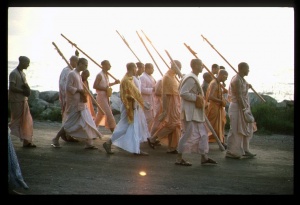SB 4.29.10: Difference between revisions
m (1 revision(s)) |
(Vanibot #0018 edit: make synonym terms in Sanskrit italic in SB - Vanisource) |
||
| Line 1: | Line 1: | ||
{{info | {{info | ||
|speaker= | |speaker=Nārada Muni | ||
|listener=King | |listener=King Prācīnabarhiṣat | ||
}} | }} | ||
[[Category:Srimad-Bhagavatam - Canto 04 Chapter 29]] | |||
[[Category:Bhagavatam Verses Spoken by Narada Muni - Vanisource|042910]] | |||
<div style="float:left">'''[[Srimad-Bhagavatam]] - [[SB 4|Fourth Canto]] - [[SB 4.29: Talks Between Narada and King Pracinabarhi|Chapter 29: Talks Between Nārada and King Prācīnabarhi]]'''</div> | |||
<div style="float:right">[[File:Go-previous.png|link=SB 4.29.9]] '''[[SB 4.29.9]] - [[SB 4.29.11]]''' [[File:Go-next.png|link=SB 4.29.11]]</div> | |||
{{RandomImage}} | |||
==== TEXT 10 ==== | ==== TEXT 10 ==== | ||
<div | <div class="verse"> | ||
khadyotāvirmukhī cātra | :khadyotāvirmukhī cātra | ||
netre ekatra nirmite | :netre ekatra nirmite | ||
rūpaṁ vibhrājitaṁ tābhyāṁ | :rūpaṁ vibhrājitaṁ tābhyāṁ | ||
vicaṣṭe cakṣuṣeśvaraḥ | :vicaṣṭe cakṣuṣeśvaraḥ | ||
</div> | </div> | ||
| Line 16: | Line 22: | ||
==== SYNONYMS ==== | ==== SYNONYMS ==== | ||
<div | <div class="synonyms"> | ||
''khadyotā''—named Khadyotā; ''āvirmukhī''—named Āvirmukhī; ''ca''—also; ''atra''—here; ''netre''—the two eyes; ''ekatra''—in one place; ''nirmite''—created; ''rūpam''—form; ''vibhrājitam''—named Vibhrājita (brilliant); ''tābhyām''—through the eyes; ''vicaṣṭe''—perceive; ''cakṣuṣā''—with the sense of sight; ''īśvaraḥ''—the master. | |||
</div> | </div> | ||
| Line 23: | Line 29: | ||
==== TRANSLATION ==== | ==== TRANSLATION ==== | ||
<div | <div class="translation"> | ||
The two gates named Khadyotā and Āvirmukhī, which have been spoken of, are the two eyes side by side in one place. The town named Vibhrājita should be understood as form. In this way the two eyes are always engaged in seeing different kinds of forms. | The two gates named Khadyotā and Āvirmukhī, which have been spoken of, are the two eyes side by side in one place. The town named Vibhrājita should be understood as form. In this way the two eyes are always engaged in seeing different kinds of forms. | ||
</div> | </div> | ||
| Line 30: | Line 36: | ||
==== PURPORT ==== | ==== PURPORT ==== | ||
<div | <div class="purport"> | ||
The two eyes are attracted by brilliant things like light. Sometimes we find that little insects are attracted by the brightness of fire and thus enter into it. Similarly, the two eyes of the living entity are attracted by bright and beautiful forms. They are entangled in these forms, exactly as the insect becomes attracted to fire. | The two eyes are attracted by brilliant things like light. Sometimes we find that little insects are attracted by the brightness of fire and thus enter into it. Similarly, the two eyes of the living entity are attracted by bright and beautiful forms. They are entangled in these forms, exactly as the insect becomes attracted to fire. | ||
</div> | </div> | ||
__NOTOC__ | |||
<div style="float:right; clear:both;">[[File:Go-previous.png|link=SB 4.29.9]] '''[[SB 4.29.9]] - [[SB 4.29.11]]''' [[File:Go-next.png|link=SB 4.29.11]]</div> | |||
__NOTOC__ | |||
__NOEDITSECTION__ | |||
Revision as of 23:55, 30 November 2017

A.C. Bhaktivedanta Swami Prabhupada
TEXT 10
- khadyotāvirmukhī cātra
- netre ekatra nirmite
- rūpaṁ vibhrājitaṁ tābhyāṁ
- vicaṣṭe cakṣuṣeśvaraḥ
SYNONYMS
khadyotā—named Khadyotā; āvirmukhī—named Āvirmukhī; ca—also; atra—here; netre—the two eyes; ekatra—in one place; nirmite—created; rūpam—form; vibhrājitam—named Vibhrājita (brilliant); tābhyām—through the eyes; vicaṣṭe—perceive; cakṣuṣā—with the sense of sight; īśvaraḥ—the master.
TRANSLATION
The two gates named Khadyotā and Āvirmukhī, which have been spoken of, are the two eyes side by side in one place. The town named Vibhrājita should be understood as form. In this way the two eyes are always engaged in seeing different kinds of forms.
PURPORT
The two eyes are attracted by brilliant things like light. Sometimes we find that little insects are attracted by the brightness of fire and thus enter into it. Similarly, the two eyes of the living entity are attracted by bright and beautiful forms. They are entangled in these forms, exactly as the insect becomes attracted to fire.